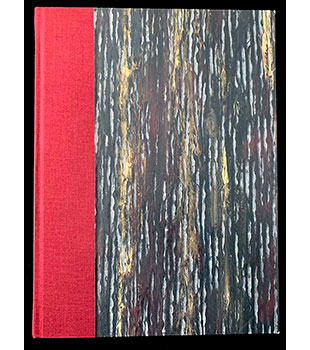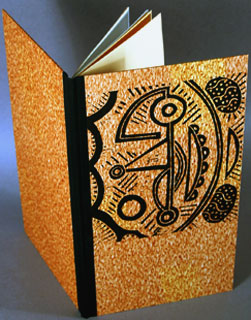
|
Red Ozier Press ~
Alabama |
|
The Red Ozier press, a private press noted for fine quality limited editions of books, pamphlets, and broadsides of unpublished poetry and prose fiction by living authors, was founded in 1976 in Madison, Wisconsin, by Steve Miller. In 1979 Miller moved to New York City, established the press there, and took on as co-proprietor Ken Botnick. Miller now resides in Tuscaloosa, Alabama, where he is Director of the Book Arts Program at the University of Alabama. |
|
Broadsides by Steve Miller |
|
THE RED OZIER: A LITERARY FINE PRESS 7.5 x 10"; xxxiv, 85 pages. One fold out illustration. Calligraphy on title page by Jerry Kelly. Paste paper by Claire Maziarczyk. Letterpress printed by Neil Shaver at the Yellow Barn Press in Council Bluffs, Iowa, on a Vandercook Universal IIII. Text type 12 pt Californian by M & H Type. Printed on dampened Rives Heavy white paper. Bound in quarter cloth over paste paper-covered boards. Leather spine label. In slipcase. Numbered. Prospectus laid in. Erratum laid in. Prospectus: "Red Ozier was one of the premier presses operating during the heyday of the American small press movement in the 1970s and 1980s. From the first title it issued in 1976 to the last in 1987, Ken Botnick and Steve Miller distinguished their press through sound editorial judgment, creative design and skillfully crafted handmade books. 'The Red Ozier: A Literary Fine Press' summarizes the energetic output of this distinctive fine press. Michael Peich has written an essay about the press and compiled a descriptive checklist that defines Red Ozier's unique place in the history of American small presses. Ken Botnick and Steve Miller have contributed illuminating essays discussing their lives and their work at Red Ozier. The volume captures the spirit of this remarkable literary press, and accords it the praise it so richly deserves now, and for generations to come." Most of the illustrations are from original engravings from the archives of the New York Public Library. A list of these illustrations and artists are included in the bibliography. One of the illustrations is a caricature drawing by Elliot Banfield of the printers, Miller and Botnick. The introduction detailing information about small presses and The Red Ozier is by Michael Peich. There are also essays at the end of the bibliography by Steve Miller and Ken Botnick. Red Hydra Press: "In 1976, inspired by Anaïs Nin who self-published her own experimental prose, Steve Miller founded Red Ozier Press in Madison, Wisconsin. Red Ozier's second home was on the 5th floor of a warehouse building on Warren Street in the Tribeca area of Manhattan. The #4 Vandercook proof press sat behind a glorious half-round window. "Steve Miller founded Red Ozier Press in 1976 in Madison, Wisconsin. While bartending and waiting on tables and wanting to make a book of his own poems, he took a letterpress printing class with Walter Hamady, a professor at the University of Wisconsin and proprietor of The Perishable Press. He printed a broadside, ‘The Balloon People Poem’, and then a chapbook of his own poems, ‘Wild Night Irises’. By the time the book was finished he knew he had to continue doing this magical thing of making books by hand. He bought a printing press in Chicago and set up a small studio on the 2nd floor of a welfare hotel in Madison. For three years he made books and broadsides there while waiting on tables at a restaurant downstairs in the hotel. “His good friend and undergraduate business student Ken Botnick egged him on, buying him the press' first school kid paper cutter. After three years the two of them moved to a loft that Ken had found in lower Manhattan, and Ken became fully involved with the daily practice of making books. “In 1988 the New York Public Library purchased the Red Ozier archive. Michael Peich wrote the Red Ozier Press bibliography, ‘The Red Ozier: A Literary Fine Press’, co-published by the New York Public Library and Yellow Barn Press." |
|
| Red Ozier Press Out of Print Titles: | |
Homage and Desecrations 6.75 x 12"; 20 pages. Van Dijck types printed in black and green on mouldmade Frankfurt. The title page has a green vertical rule with a triangular bullet in rust before the author's name. Two illustrations by Richard Mock: one within the text, printed in brown with bronzing powder mixed into the ink, and one in black on the front cover. Quarter-bound in black linen and pastepapers by Claire Maziarczyk. Pumpkin-colored endsheets. Design, printing, and binding by Ken Botnick and Steve Miller. Signed by Paz and Weinberger on the colophon, by Mock on his internal illustration. Four poems by Octavio Paz (1914 - 1998): "Amor Constante Más Allá de la Muerte" ["Love Constant Beyond Death"]; "Aspiracion" ["Aspiration"]; "Espiracion" ["Respiration"] and "Lauda" ["Tomb"]. Translation into English by Eliot Weinberger. Bilingual text accompanied by Richard Mock's artwork. Roberto Gonzalez Echevarria, Professor of Spanish at Yale University, The New York Times, May 15, 1988: "In his 1960 book, Homage and Desecrations, Mr. Paz rewrote ''Constant Love Beyond Death,'' a famous sonnet by the 17th-century poet Francisco Quevedo, thereby claiming as his poetic antecedents the baroque poets, whose echoes were audible in his poetry much earlier. His return to the baroque is emblematic. Realizing that the language inherited from the Spanish-language Romantics was derivative and hollow, modern Spanish poets reached back to Quevedo, his contemporary Luis de Gongora and their disciples as the only worthy models, poets who had achieved an original poetic revolution. Mr. Paz is torn between the glittering, imagistic world of Gongora and the wit, paradox and sober vision of Quevedo, but he seems to settle finally on the latter as a mentor, and on the 17th-century Mexican nun and poet Sor Juana Ines de la Cruz. Quevedo's language, oscillating between excrement and the most purified love, repulsion and desire, is particularly appropriate for Mr. Paz's sense of the failure of history." |
|
Page update: 09.04.2022
Home | About Us | Contact Us | New Arrivals | Fine Press & Artists' Books | Broadsides |Resource Books | Order/Inquiry
Copyright © 2021 Vamp & Tramp, Booksellers, LLC. All rights reserved.

